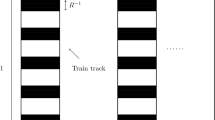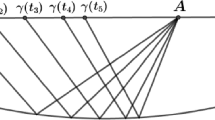Abstract
The problem of the thinnest (i.e., minimum density) covering of the plane with equal circles, solved by Kershner in 1939, can be interpreted as searching for the most economical distribution of transmission towers over a very large plane region, all towers having equal circular range, and collectively to provide reception at each point of the region. The problem of the thinnest 2-fold circle covering can be interpreted similarly, with the stronger requirement that the region should remain covered even if one of the towers stops functioning. Here we consider the intermediate variation, in which the region's coverage is to be maintained even if one of the towers experiences partial loss of power resulting in a certain decrease of its range radius. Specifically, we say that a covering of the plane with unit circular disks has margin µ (where 0 ≤ µ ≤ 1) if any one arbitrarily chosen disk can be replaced with a concentric disk of radius r = 1 - µ and the plane still remains covered. This concept provides a continuous transition from simple covering (margin 0) to 2-fold covering (margin 1). In this paper we determine the minimum density \(\vartheta _L^{1 + \mu } \) among all lattice circle coverings that have margin µ, and the lattice λµ that produces the minimum density. Somewhat surprisingly, the optimal lattice λµ behaves discontinuously and is non-unique at a pair of values of µ. As µ varies from 0 to 1, at one point λµ changes suddenly from an equilateral triangular lattice into a square lattice and then, at another point, into a certain rectangular lattice.
Similar content being viewed by others
REFERENCES
W. J. Blundon, Multiple covering of the plane by circles, Mathematika 4 (1957), 7-16.
U. Bolle, On the density of multiple packings and coverings of convex discs, Studia Sci. Math. Hunger. 24 (1989), 119-126.
M. J. Cohn, Multiple lattice covering of space, Proc. London Math. Soc. (3) 32 (1976), 117-132.
L. Danzer, Drei Beispiele zu Lagerungsproblemen, Arch. Math. 11 (1960), 159-165.
V. C. Dumir and R. J. Hans-Gill, Lattice double coverings in the plane, Indian J. Pure Appl. Math. 3 (1972), 466-480.
V. C. Dumir and R. J. Hans-Gill, Lattice double packings in the plane, Indian J. Pure Appl. Math. 3 (1972), 481-487.
P. ErdŐs and C. A. Rogers, Covering space with convex bodies, Acta Arith. 7 (1962), 281-285.
G. Fejes TÓth, Multiple packing and covering of the plane with circles, Acta Math. Acad. Sci. Hungar. 27 (1976), 135-140.
L. Fejes TÓth, Regular figures, Pergamon Press, New York, 1964.
L. Few, Multiple packing of spheres, J. London Math. Soc., 39 (1964), 51-54.
L. Few, Double packing of spheres: a new upper bound, Mathematika 15 (1968), 88-92.
A. Florian, Mehrfache Packung konvexe Körper, Österreich. Akad. Wiss. Math.-Natur. Kl. Sitzungsber. II 186 (1978), 238-247.
A. Heppes, Über mehrfache Kreislagerungen, Elem. Math. 10 (1955), 125-127.
R. Kershner, The number of circles covering a set, Amer. J. Math. 61 (1939), 665-671.
J. Linhart, Eine Methode zur Berechnung der Dichte einer dichtesten gitterförmigen k-fachen Kreispackung, Arbeitsber. Math. Inst. Univ. Salzburg (1983).
P. Mani and J. Pach, Decomposition problems for multiple coverings with unit balls, Pre-print, 1990.
J. Pach, Decomposition of multiple packing and covering, Diskrete Geometrie Vol. 2., pp. 169-178, Kolloq. Inst. Math. Univ. Salzburg, 1980.
A. H. TemesvÁri, Eine Methode zur Bestimmung der dünnsten gitterförmigen k-fachen Kreisüberdeckungen, Studia Sci. Math. Hungar. 23 (1988), 23-35.
A. H. TemesvÁri, J. HorvÁth and N. N. Yakovlev, A method for finding the densest lattice k-fold packing of circles, Mat. Zametki 41 (1987), 625-636, 764 (in Russian). English transl. Math. Notes 41 349–355.
A. Thue, Über die dichteste Zusammenstellung von kongruenten Kreisen in der Ebene, Christiania Vid. Selsk. Skr. 1 (1910), 3-9.
Rights and permissions
About this article
Cite this article
Bezdek, A., Kuperberg, W. Circle Covering With a Margin. Periodica Mathematica Hungarica 34, 3–16 (1997). https://doi.org/10.1023/A:1004275121878
Issue Date:
DOI: https://doi.org/10.1023/A:1004275121878




